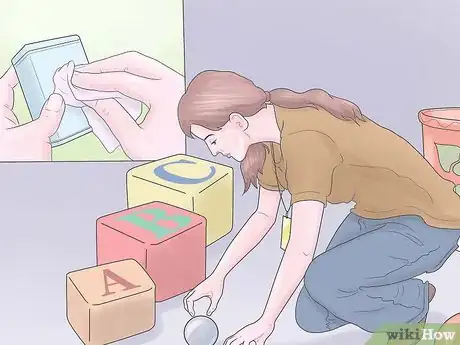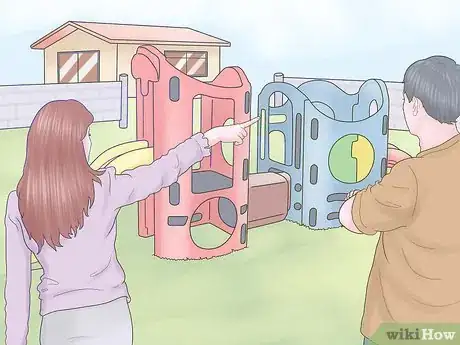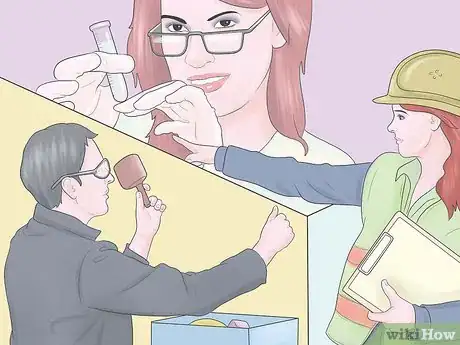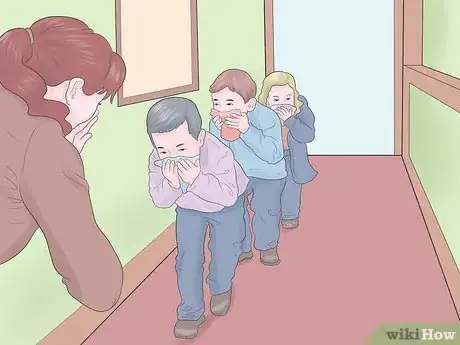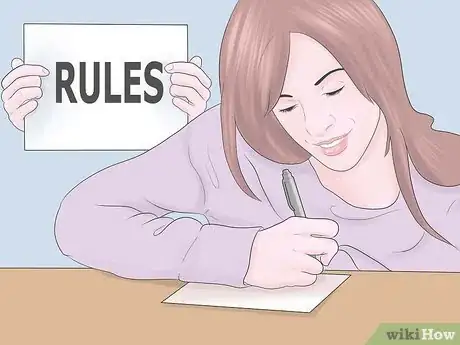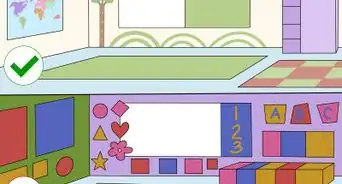X
wikiHow is a “wiki,” similar to Wikipedia, which means that many of our articles are co-written by multiple authors. To create this article, 16 people, some anonymous, worked to edit and improve it over time.
This article has been viewed 163,715 times.
Learn more...
When choosing a preschool for their children, parents might consider a number of different factors, including cost, location, curriculum, hours of operation and environment. A preschool environment should be safe, above all things, and ensuring safety in a preschool setting encompasses a number of considerations. Follow these guidelines for how to provide a safe environment at preschool.
Steps
-
1Hire ample, qualified staff members. You should have enough employees to supervise all of the children in your preschool, and to ensure that all of the areas in the preschool where children congregate are monitored at all times by staff members. Additionally, you should require that your staff is trained in cardiopulmonary resuscitation (CPR), and is certified in first aid.
-
2Check the play area regularly.
- Employees need to have references checked on, and pass a background check.
- In the US (and most other locales) there are legal ratios of staff to children, dependent on age.
- Staff get sick, need to go to training sessions and meetings, need to go to medical appointments, vacations take lunches and breaks--be sure there is coverage with substitutes to allow this.
Advertisement -
3Arrange the classroom in a way that allows you to see all of the children, at all times. Make sure there are no blind spots where children can get lost from your sight.[1]
- If you use cubicles or partition walls, configure them in a way that allows you to see around them from as many angles as possible. For example, it is better to put a partition wall at a right angle to a perimeter wall than it is to put 2 partitions walls at right angles to each other in the center of the room.
- Set up play areas in the center of the room.
- Arrange chairs, desks and work tables in circles.
-
4Adhere to food safety guidelines. When it comes to preparing, storing and serving food, there are a number of precautions you should take to ensure daycare safety. Your government's daycare facility regulatory agency can provide you with a comprehensive manual of food safety guidelines.
-
5Safeguard the outdoor play area.[2]
- Ground covering must be soft to cushion falls.
- The height of swings, slides and other playground equipment must be a safe distance from the ground.
- There should be no bolts, nuts, screws or other fasteners protruding from the playground equipment in a way that could potentially harm children.
- Openings must be large enough to ensure that body parts cannot get trapped. A standard rule is to make sure there are no openings between 3.5 inches (8.4 cm) and 9 inches (21.6 cm) wide.
- Space play equipment at least 12 feet (3.7 m) apart.
- Clear traffic areas of tripping hazards. Examples of tripping hazards include tree branches, boulders, sudden shifts in elevation and tree stumps.
- Check playground equipment regularly for ease of operation and structural integrity.
- Elevated platforms should have guard rails.
- Encircle the playground with a tall safety fence, and make sure any gates leading to the outside are locked.
-
6Keep chemicals locked away from children. In a preschool environment, cleaners, insecticides, first aid solutions, medications and all other toxic substances should be kept in a high, flame-resistant and safety-locked cabinet.
-
7Inspect for environmental hazards regularly. Common environmental safety issues include water impurities, lead-based paint, mercury, asbestos, waste management and indoor air pollutants like mold/mildew, carbon monoxide, tobacco smoke, allergens and dust. Call the appropriate authorities to the premises to test for environmental hazards before allowing children to enter the preschool environment, and place applicable electronic detectors throughout the facility.[3]
-
8Have emergency plans in place. Conduct fire and natural disaster drills on a regular basis to ensure that everyone at the preschool is familiar with the proper procedures for handling emergency situations.[4]
-
9Create rules. Rule lists can be used in a variety of ways to promote a safe environment at preschool.[5]
- Post school rules clearly where are preschoolers can see them, and be sure to address them on a regular basis so that the children are familiar with them. For example, rules like "keep your hands to yourself" and "tell the teacher if you have a problem with another student" can help prevent physically harmful arguments in the preschool environment, and rules about washing hands and covering sneezes can help prevent the spread of illness.
- Establish a set of rules for picking up and dropping off preschoolers. For example, you may require parents to provide photo IDs, fill out forms for other parties they wish to pick up their children, sign in and out, stay inside a pickup zone during pickup time and/or call ahead of time if the pickup method is to temporarily change.
Advertisement
Community Q&A
-
QuestionHow can I create safety measures for stairs at a preschool?
 Community AnswerAffix a gate to the stairs to prevent children from climbing up or down with out teacher’s guidance. Put an anti-slip surface on every step of the stairs. Make sure children hold the handrail whenever they going up or down the stairs.
Community AnswerAffix a gate to the stairs to prevent children from climbing up or down with out teacher’s guidance. Put an anti-slip surface on every step of the stairs. Make sure children hold the handrail whenever they going up or down the stairs. -
QuestionHow do I compile an emergency plan?
 VermontGalTop AnswererIn the United States, there are standards that licensed preschools must comply with, and within that are specific emergency plans that must be addressed (fire, weather, loss of power, etc.). These standards are usually available at your state's licensing agency, often online.
VermontGalTop AnswererIn the United States, there are standards that licensed preschools must comply with, and within that are specific emergency plans that must be addressed (fire, weather, loss of power, etc.). These standards are usually available at your state's licensing agency, often online. -
QuestionHow can I keep strangers out of my preschool to protect the children?
 Community AnswerKeep doors that enter the playground and the front entrance locked. Use a buzz-in security system and only allow entrance to authorized people. Make tradespeople and delivery people wait until you have checked who they are. Always ask parents/guardians for proof that they are allowed to take the child home with them when it is time to leave; this can be done by having them sign forms saying who can collect their child (e.g. mom, dad, grandparent, aunt, etc. but nobody else). Get to know the parents really well so you know them by sight and name.
Community AnswerKeep doors that enter the playground and the front entrance locked. Use a buzz-in security system and only allow entrance to authorized people. Make tradespeople and delivery people wait until you have checked who they are. Always ask parents/guardians for proof that they are allowed to take the child home with them when it is time to leave; this can be done by having them sign forms saying who can collect their child (e.g. mom, dad, grandparent, aunt, etc. but nobody else). Get to know the parents really well so you know them by sight and name.
Advertisement
Warnings
- Avoid pressure-treated wood for playground equipment, as it is treated with toxic chemicals that are dangerous to children.⧼thumbs_response⧽
- Be aware that most of the factors concerning daycare safety are regulated by the government and, therefore, can differ from area to area. Be sure to check with your government's preschool regulatory agency to ensure you are in legal compliance with safety standards.⧼thumbs_response⧽
Advertisement
References
- ↑ http://www.the-preschool-professor.com/preschool-safety.html
- ↑ https://nces.ed.gov/pubs2003/maintenance/chapter4_2.asp#3
- ↑ https://nces.ed.gov/pubs2003/maintenance/chapter4_2.asp#3
- ↑ https://www.rasmussen.edu/degrees/education/blog/preschool-classroom-safety/
- ↑ http://www.the-preschool-professor.com/preschool-safety.html
- http://nces.ed.gov/pubs2003/maintenance/chapter4.asp
About This Article
Advertisement

